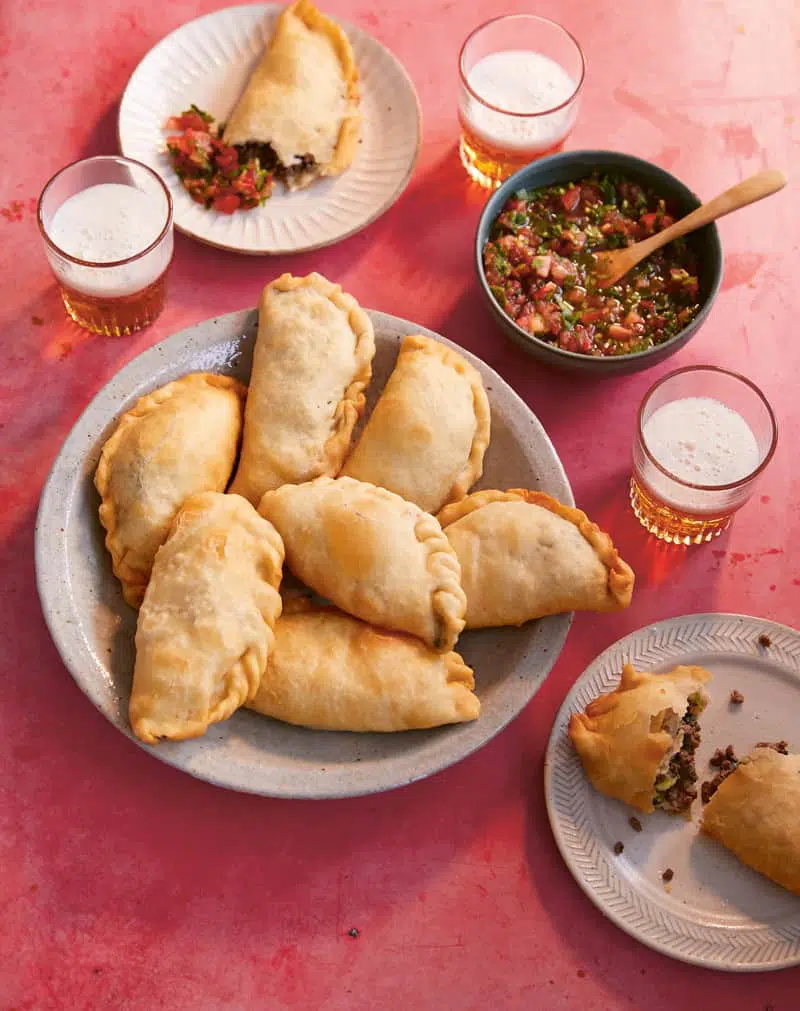I made the moreish honey and granola bars from Taste Tibet this week and it reminded me that I have another recipe from the book to share with you. Sha balep are little Tibetan pastries that I think of as sharing the same eating space with foods like Mexican empanadas or Indian samosas or Aussie meat pies. That is, make them en masse, freeze them and then heat them up for snacks, easy dinners (they are traditionally served with soup) or even for breakfast as the Tibetans do.
I mentioned in the article I wrote to accompany the granola bars that sharing food from other cultures is a preoccupation of mine. Sha balep are an example of this: the food has a story and the story enhances the food.
In Tibet, you’ll most likely find yak meat in your sha balep, but beef mince substitutes just fine. Unless you happen to know where to get your hands on yak meat in Australia? Hmm.
Enjoy making these little meat pastries, and perhaps finding a new love of Tibetan rap music as Julie and Yeshi suggest below…
Sha balep (Tibetan pasties)

From Taste Tibet by Julie Kleeman and Yeshi Jampa
Sha balep (literally, ‘meat breads’) are widely and wildly loved by Tibetans. Vegans, do not look away now! You can make a vegan version using the tofu, Chinese cabbage and mushroom filling on page 161. Potatoes are another good fit, but have a go with any veggies you enjoy and have to hand.
There’s a saying in Tibetan, ‘If you mess up, I’ll give you a sha balep’, which means that if you step out of line, you’ll get a slap. The Tibetan rapper Shapaley has produced a wonderful ode to sha balep that references this expression. It’s a very catchy tune to listen to – YouTube is your friend – while you make these delicious pasties.
In central Tibet many people eat them for breakfast, but they are more typically served for lunch or dinner, usually with a soup side. We like to serve them with Yeshi’s super salsa (see page 200): the trick is to take a bite out of the sha balep and then spoon in some of the fresh-tasting salsa for a wonderfully refreshing contrast.
Makes 10
For the dough
450 g (3 cups) self-raising flour, plus extra for dusting
1 tablespoon cooking oil
For the filling
500 g (1 lb 2 oz) minced (ground) beef, ideally 15–20% fat content
1 teaspoon fine sea salt
2 tablespoons cooking oil
½ teaspoon crushed Sichuan peppercorns (yerma)
½ teaspoon ground coriander
1 small red onion, finely chopped
1 large garlic clove, finely chopped
50 g (1¾ oz) spinach, washed and finely chopped
Cooking oil, for deep-frying
For the dough, place the flour and oil in a mixing bowl. Using your dominant hand, start pinching together the oil and the flour, while slowly pouring in 200 ml (7 fl oz) of warm water with the other. Mix and then knead, adding just enough water to make a dough. As the dough comes together, keep kneading until you have a nice ball of dough in the bowl. Cover and set aside for 15 minutes.
Meanwhile, for the filling, put the beef, salt and 1 tablespoon of the oil into a bowl and mix together, either with a fork or by hand. Add the Sichuan pepper and coriander and stir well, followed by the onion, garlic and spinach. Mix thoroughly. Heat the other tablespoon of oil in a frying pan, and when it’s hot, stir the meat mixture through it for 4–5 minutes until the beef browns. Set aside and allow to cool.
Sprinkle a little flour onto your work surface. Take the dough out of the bowl and loosely roll it into a sausage shape. Divide it evenly into eight pieces, then roll each piece between your palms into a ball.
Working with one ball of dough at a time, lightly flatten it with your hands and then roll it out with a rolling pin, pushing and pulling the dough up and down quickly and firmly. Use your other hand to hold the dough and turn it little by little as you go. You are aiming for a circle about 10–12 cm (4–4½ inches) in diameter, with the middle a bit thicker than the edges.
Spoon a generous amount (about 2–3 tablespoons) of the cooled filling into the centre, then gently fold one side of the circle over the filling to meet the other side.
Starting in the middle, use your fingertips to press the edges together into the board, trying not to trap any pockets of air inside. Just before you completely seal the pasty, gently press down on it to release any trapped air and then close. Lift the joined edge up bit by bit, pressing it back into the pasty to seal it again. When you are confident it is well sealed, you can crimp the edge with as much flair as you dare – and if you are not satisfied with the design, you can always use a fork. Set aside while you make the rest of the pasties.
When you’re ready to cook your sha balep, pour a 7.5 cm depth of cooking oil into a large, stable wok and place over a high heat. (Alternatively, you could use a frying pan to shallow-fry the sha balep, turning them over once halfway through, in which case you will only need a 2 cm (¾ inch) depth of oil.) Check the temperature of the oil by tossing in a tiny scrap of dough: if it bubbles vigorously and rises quickly to the surface, you are good to go. Turn the heat down to low and slide in as many sha balep as will fit into the pan – probably no more than four at a time. Once they are in the oil, you can use tongs to move them around and turn them over from time to time, so they cook evenly.
Let the sha balep cook for 4–5 minutes, or until they are golden brown, then drain on paper towel before serving.
Yeshi says ‘If you make your sha balep nice and plump, you shouldn’t end up with any left over filling, but if you do it can be boiled for a few minutes in some water to make a nice side soup – add a little coriander for greenery and extra flavour. If by any chance you have any dough left over, roll it out flat and use it to make some Numtak balep (fried breakfast bread or Balep (Tibetan flatbread).’
Images and recipe text from Taste Tibet by Julie Kleeman and Yeshi Jampa, photography by Ola O. Smith. Murdoch Books RRP $49.99.


